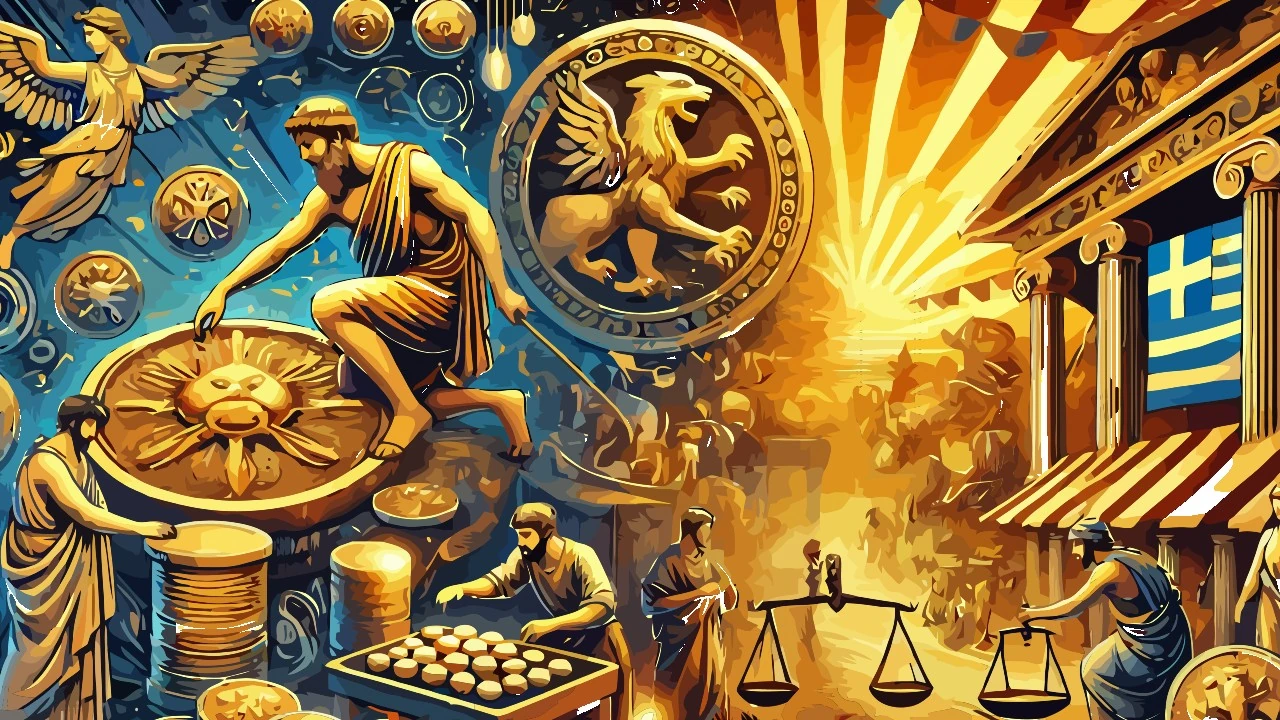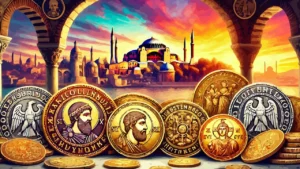The concept of money revolutionized the way human societies conducted trade, moving from barter to a more sophisticated system of economic transactions. The birth of the first money marked the beginning of modern economic history, laying the foundations for markets, finance, and today’s globalized economies.
In this article, we will explore the origins of the first coin, its development, and the pivotal role that gold has acquired as a unit of value.
Contents
#1. Barter and its limits
Before the invention of money, ancient societies used barter to exchange goods and services. However, this system had significant limitations: the difficulty in matching supply and demand (the so-called “double coincidence of needs”), the impossibility of preserving value over time and the lack of a shared unit of measurement made barter inefficient. These critical issues pushed civilizations to seek more functional solutions, leading to the adoption of valuable objects such as shells, salt, livestock and precious metals as instruments of exchange.
Barter also limited the growth of markets and the specialization of labor, as direct exchanges imposed practical constraints on economic actors. Communities that depended exclusively on barter had difficulty accumulating wealth or creating lasting stores of value. This system worked only in local and narrow settings, but as trade expanded and social complexity increased, the need for a more effective means of exchange became apparent.
Thus, some civilizations began to use goods considered precious or difficult to obtain as means of exchange: salt was used as money in ancient Rome, while shells played a similar role in several African and Asian societies. However, none of these tools managed to completely solve the intrinsic limitations of barter, paving the way for the introduction of metal money and therefore also silver and gold.
#2. The birth of the first coin in Lydia
The first recognized coinage in history originated in the kingdom of Lydia, in what is now western Turkey, around the 7th century BC. King Alyattes issued the first coins minted in electrum, a natural alloy of gold and silver, giving rise to a standardized monetary system. Lydian coins, often decorated with the symbol of the lion, guaranteed a recognized and accepted value within the kingdom and in neighboring territories. This new medium of exchange facilitated transactions, reduced the risks associated with barter, and contributed to the economic growth of the kingdom. The standardization of the weight and purity of coins was crucial to establishing trust between merchants and citizens.
The use of electrum alloy also responded to practical needs: the combination of gold and silver offered significant intrinsic value while maintaining good workability. Over time, minting techniques improved, allowing for increasingly uniform coins. This process helped to strengthen the central authority of the king, as the minting of coins became a symbol of state power.
Lydian coins not only facilitated internal trade, but also made regional trade possible. Merchants from Greece and Asia Minor soon adopted the Lydian monetary system, helping to spread the concept of money throughout the eastern Mediterranean.
#3. The evolution of ancient coins
After the Lydian experience, the use of money spread rapidly throughout the ancient world. The Greeks, the Persians and later the Romans developed increasingly complex monetary systems, using gold, silver and bronze to mint coins of different values. Each civilization adopted symbols and engravings representing political or religious power, making coins also propaganda tools. The spread of coins encouraged large-scale trade, creating economic networks between distant territories and stimulating the growth of the first mercantile cities.
In Greece, for example, city-states minted their own coins, with local symbols and patron deities. This allowed the development of a dynamic economic system, in which coins also became collectibles or stores of value. The Romans further refined the monetary system, introducing bronze coins for everyday transactions and gold and silver coins for large trades and payment of troops.
The concept of money thus took on a dual role: as a medium of exchange and as a symbol of political power. As Roman influence grew, the silver denarius became one of the most widely used coins of the ancient world, establishing a model that would influence future monetary systems.
#4. The price of gold in ancient Greece
In Greece, the use of coins led to a reflection on the intrinsic value of precious metals. People began to recognize that not all coins had the same gold content, leading many to spend the less pure coins and keep the more valuable ones. This behavior, known as Gresham’s law, led to the need for a gold standard to accurately determine the value of coins in circulation.
👉 Read also: The 9 Most Famous Economic Effects in History
Merchants and money changers began to carefully evaluate the precious metal content of each coin, giving rise to one of the first metal markets. This grading system led to stricter standards in coin production and prompted authorities to ensure the purity of the coinage.
The price of gold also had a significant impact on the wealth reserves and economic strategies of Greek city-states. Some polis accumulated gold reserves as collateral for military expenditures or to cope with economic crises, while others used the price to establish fairer exchange rates in foreign trade.
This process laid the foundation for the development of the first concepts of monetary economics and financial markets, influencing future banking and commercial practices that would consolidate in the following centuries.








Leave a Reply